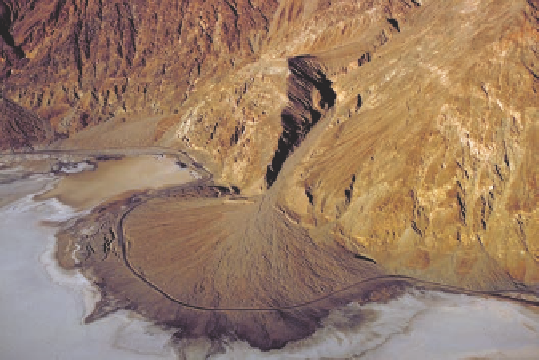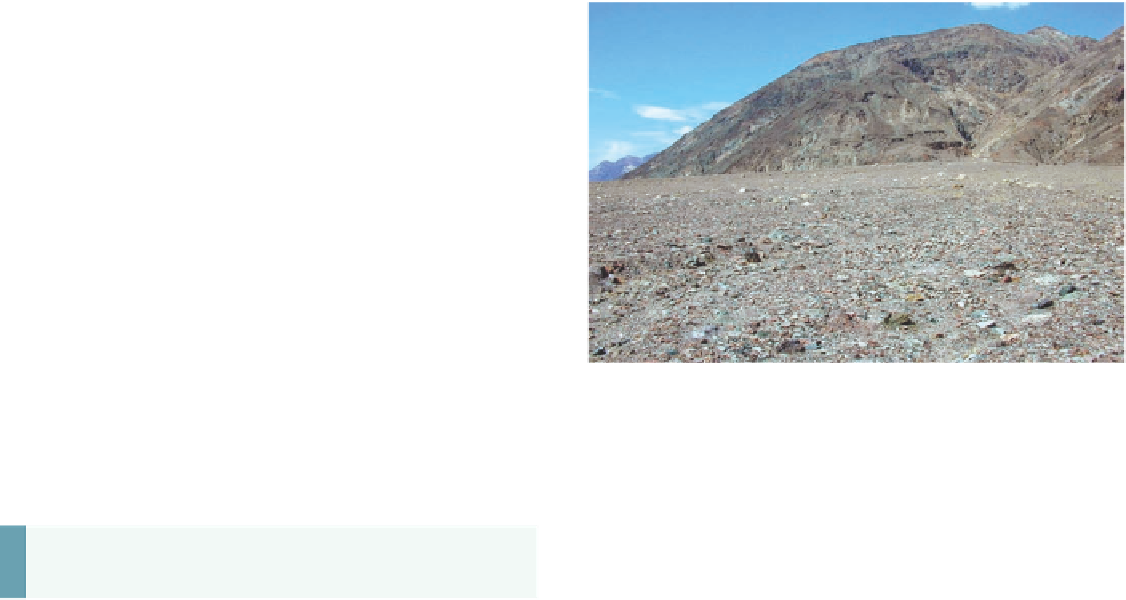Geoscience Reference
In-Depth Information
(a)
(b)
Figure 18.10 Alluvial fans in the southwestern United States.
(a) This typical alluvial fan in Death Valley, California, has a fan-like shape
where sediment is deposited by water periodically flowing out of the mountains. (b) Surface of an alluvial fan in Death Valley, California. Note
the steep slope and coarse texture of this surface.
regions because (1) strong winds are common, (2) a large
supply of sand and silt is often available that can be blown,
and (3) vegetation cover is minimal and the wind is thus free
to erode sediment. This section of the chapter focuses on
the way that moving air behaves and the way it shapes the
landscape.
KEY CONCEPTS TO REMEMBER ABOUT
ARID LANDSCAPES
1.
Approximately one-third of the Earth's land surface is a
mix of arid and semi-arid deserts.
2.
Arid lands are associated with subtropical high-pressure
systems, rain shadows, and locations that are deep
within continents.
The Fluid Behavior of Wind, Erosion,
and Sediment Transport
Like water, wind behaves according to specific physical laws
associated with fluids. From this perspective, the primary dif-
ference between wind and water is that water is much denser
than wind. For example, think of how much more buoyant you
are in water than in air. Because of this variation in buoyancy,
winds must have speeds almost 30 times greater than the speed
of water currents to move the same particle.
Both water and wind behave as a fluid with a predictable
velocity gradient in the vertical dimension. When air flows
over a bare, unvegetated surface, a very thin boundary layer is
present where the wind velocity is zero. Above this layer, to a
height of about 3 cm, velocity initially increases rapidly, but
then slows with additional height.
The ability of wind to erode sediment is similar to that
of water in that sediment particles begin to move once a criti-
cal threshold velocity is reached. In most circumstances, the
mobilization of sand grains begins when wind velocity is
greater than about 5 m/sec (
∙
16 ft/sec) at a height of approx-
imately 1 m (3.3 ft) above the ground. This threshold varies
depending on the size of any given particle, with small grains
more easily moved than larger ones (Figure 18.11). To see how
wind moves sediment, consider Figure 18.12 and how a single
3.
Deserts and other dry lands are excellent places to
study geomorphology because the vegetation cover is
relatively sparse, and thus features such as rock struc-
ture and landforms are easy to see.
4.
In many places of the American West, a distinct pro-
gression of landforms is associated with horizontal rock
structure. This progression includes plateaus, canyons,
mesas, buttes, pinnacles, and plains.
5.
A playa is a dried lake bed that occurs in plains and
grabens. These lakes temporarily fill with water during
wet periods and subsequently dry out during periods of
drought.
6.
An alluvial fan is a landform created by deposition of
stream sediment at the base of steep hillslopes where
the gradient drops at the intersection of the basin.
Eolian Erosion and Transport
In addition to the progression of erosional landforms that oc-
curs in many deserts, another prominent geomorphic agent in
these areas is
eolian
processes
, which are those involving
the wind. Although such processes can occur in subhu-
mid and even humid regions, they are most active in desert
Eolian processes
Geomorphic processes associated with the
way that wind erodes, transports, and deposits sediment.



